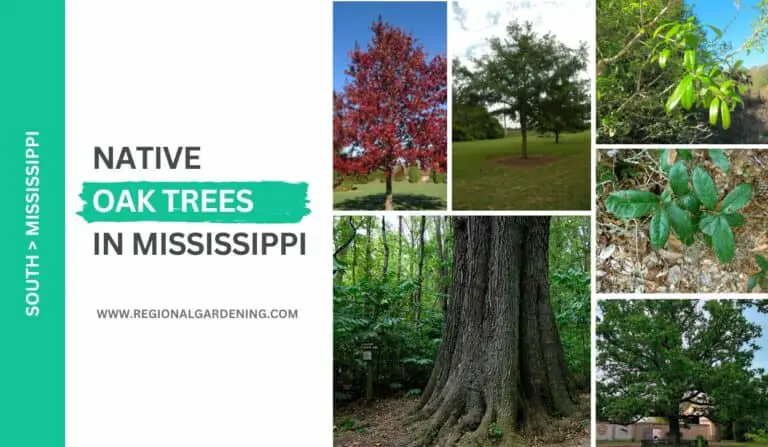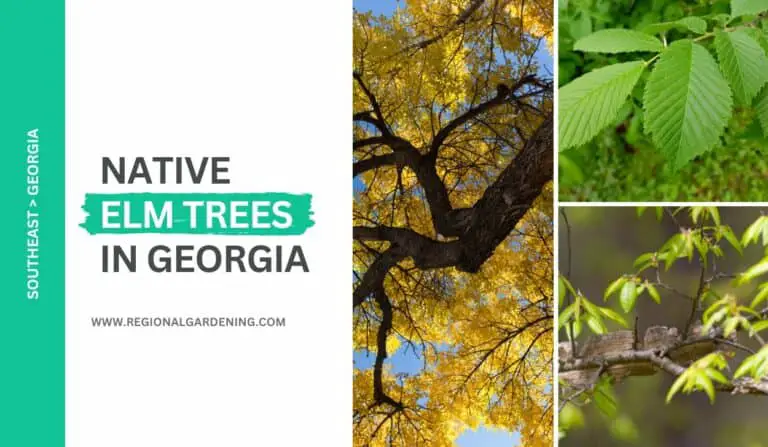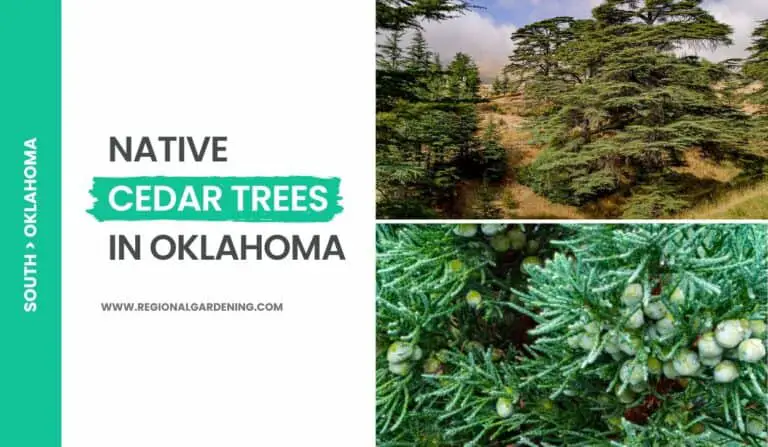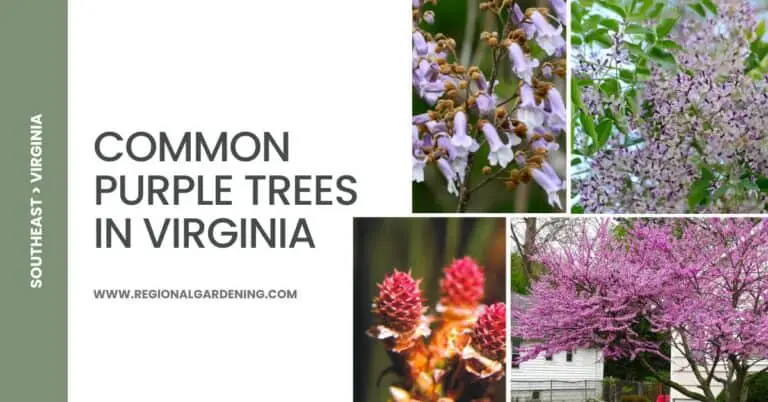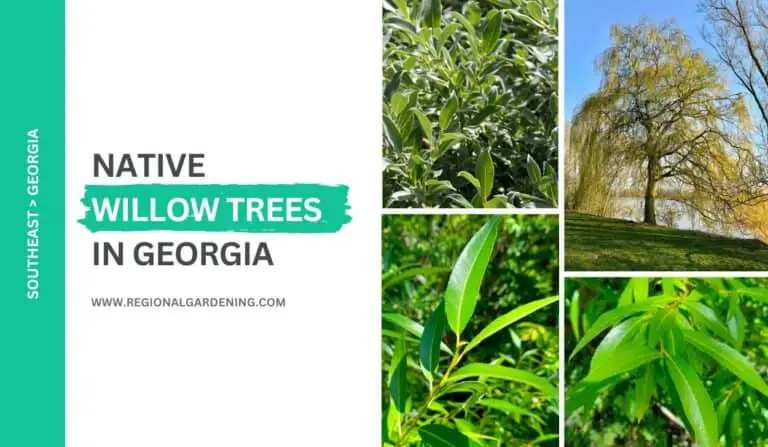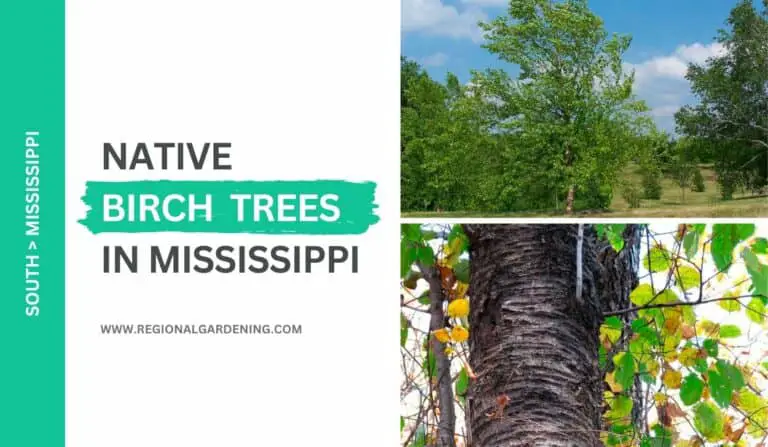9 Common Palm Trees In Mississippi (With Photos)
Exploring the lush landscapes of Mississippi reveals a captivating array of palm trees, each with its unique charm and contribution to the region’s beauty.
From the stately presence of the tall cabbage palm, swaying gracefully against the sky, to the charmingly diminutive saw palmetto, these trees adorn the state with their diverse forms and hues.
This article delves into the enchanting world of most commonly seen palm trees in Mississippi, shedding light on their characteristics, significance, and the role they play in shaping the local ecosystem.
Let’s begin.
1. Cabbage Palm
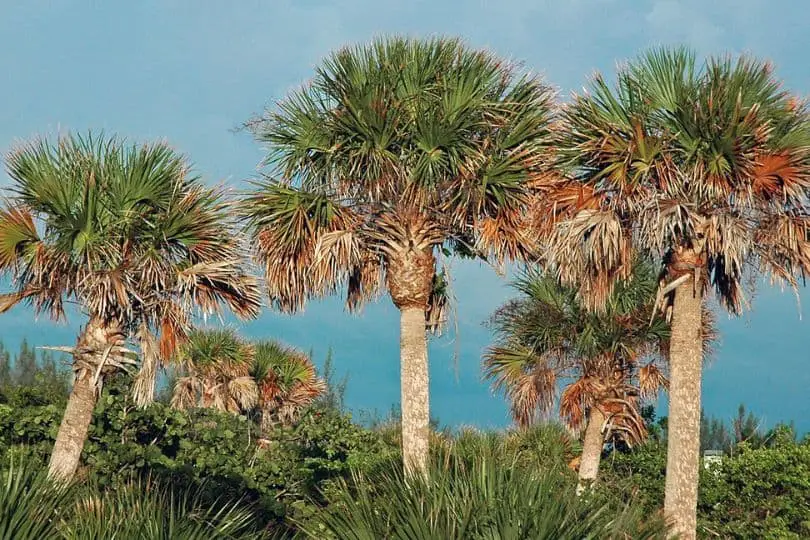
- Scientific Name: Sabal palmetto
- Common Name(s): Cabbage Palm, Sabal Palm
- Mature Height: 50-70 feet
- Native Region: Southeastern United States
- Uses: Landscaping, street planting, state tree of Florida and South Carolina
The Cabbage Palm, also known as Sabal Palmetto, is one of the most common palm trees in Mississippi landscapes.
The tree is notable for its incredibly straight, gray trunk, which allows it to reach heights of up to 65 feet. It is well-known as the state tree of Florida and South Carolina, but it is also popular and plentiful in Mississippi.
It is well-known for its enticing foliage, which features rich, costapalmate leaves that radiate in a pleasing fan design. This foliage, which ranges in color from deep green to bluish-green, grows at the top of the outer bark. When fully mature, the leaves can span up to 6 feet across, making a significant statement in any garden or landscape.
The Cabbage Palm is a popular choice among gardeners since it can withstand strong coastal winds and tolerates a variety of soil conditions. This tree’s durability is admirable, as it can withstand flooding and droughts and has a great resistance to fire. Aside from its flexibility, the Cabbage Palm provides an edible cabbage-like substance known as ‘heart of palm’.
During the late spring and summer, it is adorned with small white blossoms, and it later develops into a black, berry-like fruit that birds love. Numerous bird species rely on the thick, fibrous berry as a vital and healthy food source. While this fruit is not commonly ingested by humans due to its high gritty fiber content, it is an important component of the diet of local fauna.
The Cabbage Palm has played an important role in the development of Mississippi’s local ecology and culture over the years. Its leaves, which were originally gathered by indigenous inhabitants to build roofing for their homes, are still an essential resource item. As an ornamental tree, it enhances the aesthetic beauty of the neighborhood by beautifying driveways, roadways, and parks.
2. California Fan Palm
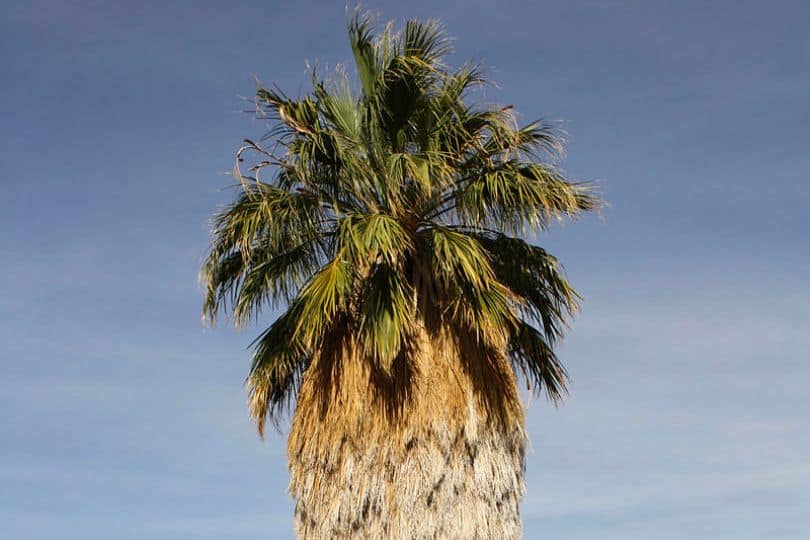
- Scientific Name: Washingtonia filifera
- Common Name(s): California fan palm, petticoat palm
- Mature Height: 40-60 feet
- Native Region: California and southwest U.S.
- Uses: Landscape, ornamental
The California fan palm, Washingtonia filifera, gets its name from the fan-like form of its big, vivid green leaves. This palm species can grow to be 40 to 60 feet tall, making it a prominent presence in any environment. It is native to California and the Southwestern United States and is recognizable by its broad, gray trunk, robust crown, and frond skirts that hang beneath the crown, earning it the amusing moniker “petticoat palm.”
California fan palms are resilient and can withstand desert environments, where they are commonly seen. These trees enjoy sun-drenched locations, and while they may tolerate moderate ice, repeated freezing conditions can harm the fronds.
Despite their desert origins, these palms have an unusual affinity for water, naturally congregating around desert springs and oasis and displaying a rare adaptation that allows them to survive in both dry and marshy situations.
Because of their majestic stature and tropical appearance, California fan palms are frequently employed as ornamental plants in landscapes. Their cultivation, however, necessitates enormous spaces, making them unsuitable for small yards. Their extensive, spreading roots may suffocate the growth of surrounding plants.
Despite these constraints, the California fan palm offers as a gorgeous centerpiece for garden aficionados with plenty of space, transmitting a sense of stability and tranquillity. With their magnificent, fan-like fronds waving gently in the wind, they contribute significantly to the aesthetics.
3. Windmill Palm
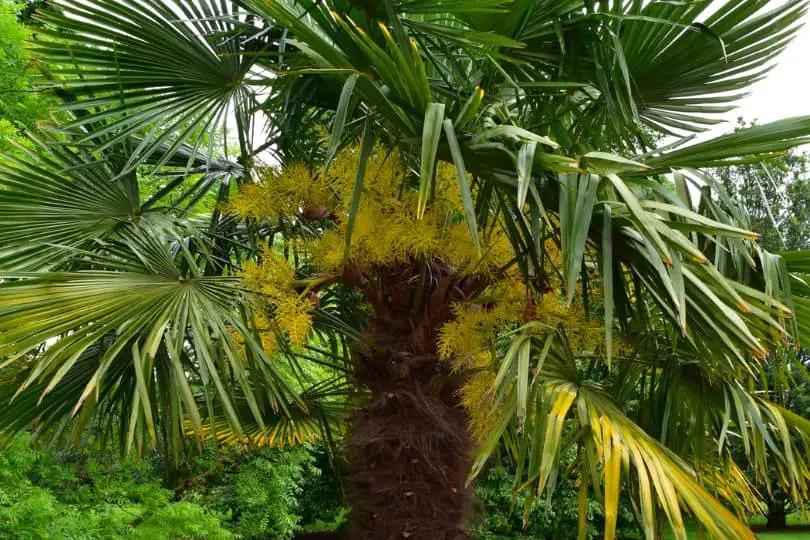
- Scientific Name: Trachycarpus fortunei
- Common Name(s): Windmill Palm, Chinese Windmill Palm
- Mature Height: 20-40 feet
- Native Region: Central China
- Uses: Ornamental, landscaping
One of the most commonly found medium-sized palm trees in Mississippi, Trachycarpus fortunei, also known as Windmill Palm or Chinese Windmill Palm, is a tough palm native to central China’s mountainous terrain. It gets its name ‘Windmill’ from its broad, fan-like fronds that sway softly even in the wind, mimicking the blades of a windmill in motion. Mature trees can grow to heights of 20 to 40 feet.
The Windmill Palm has a single, slender, fuzzy brown stem that retains the remnants of former leaf bases, creating a striking herringbone pattern in the landscape. The upper surface of the leaves is a glossy dark green, while the underside is a paler grayish-blue.
Windmill Palms are cold resilient in comparison to other palm species and can live in temperate settings. Because they can resist temperatures as low as -10 degrees Celsius, they are a popular choice for landscaping in chilly climes. They love full to partial sunlight but may tolerate shade, giving them variety in landscape placement.
Windmill Palm is an attractive tree that lends a tropical touch to landscapes and gardens. It is commonly utilized as a single specimen or in group plantings to add height and dimension. Its fan-shaped fronds add a unique aesthetic interest, and its compact stature makes it ideal for urban gardens or constrained locations.
The Windmill Palm is also very simple to care for. It requires just modest watering and is resistant to the majority of pests and diseases, making it an excellent choice for both novice and experienced gardeners. The optimal substrate for its growth is well-drained soil rich in organic materials.
4. Jelly Palm
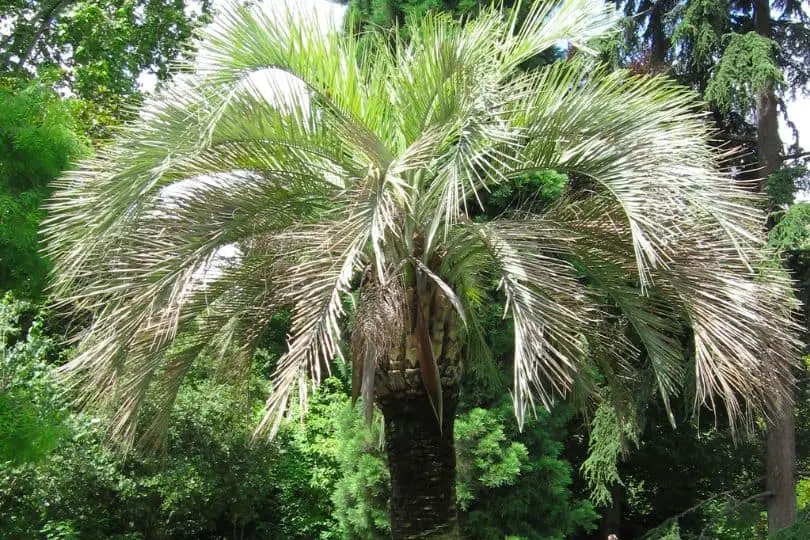
- Scientific Name: Butia capitata
- Common Name(s): Jelly Palm, Pindo Palm, Wine Palm
- Mature Height: 15-20 feet
- Native Region: South America, specifically Brazil and Uruguay
- Uses: Landscaping, ornamental, edible fruit
Butia capitata, also known as the Jelly Palm, Pindo Palm, or Wine Palm, is a beautiful palm endemic to South America, including Brazil and Uruguay. Its mature height ranges from 15 to 20 feet. Its distinctive feather-like arching fronds and blue-green leaves make it a visually appealing landscape feature.
Jelly Palm has a strong, distinctive trunk that carries a crown of gracefully arching leaves. The feather-like leaves have a gorgeous blueish-green tint that glistens in the sunlight. When in bloom, the tree bears clusters of yellow-orange flowers that turn into tasty fruits, hence the name Jelly Palm.
Jelly Palm is well-adapted to a variety of soils and is wind resistant, making it an excellent choice for coastal areas. It prefers full sun but may readily take little shade. It can tolerate slight frost in freezing conditions, but it does not do well in prolonged cold spells.
Aside from its landscape value, the Jelly Palm is well-known for its delectable, jelly-like, yellow to orange fruits. These fruits are frequently processed into jelly, wine, or eaten fresh, giving the tree utilitarian use in addition to its beautiful significance.
The Jelly Palm is a popular choice for residential and commercial landscaping because of its versatility and striking beauty, providing a tropical vibe to any location and enhancing the overall appeal of the environment. It is a tempting choice for both beginner and experienced gardeners because to its low maintenance requirements.
5. Mediterranean Fan Palm
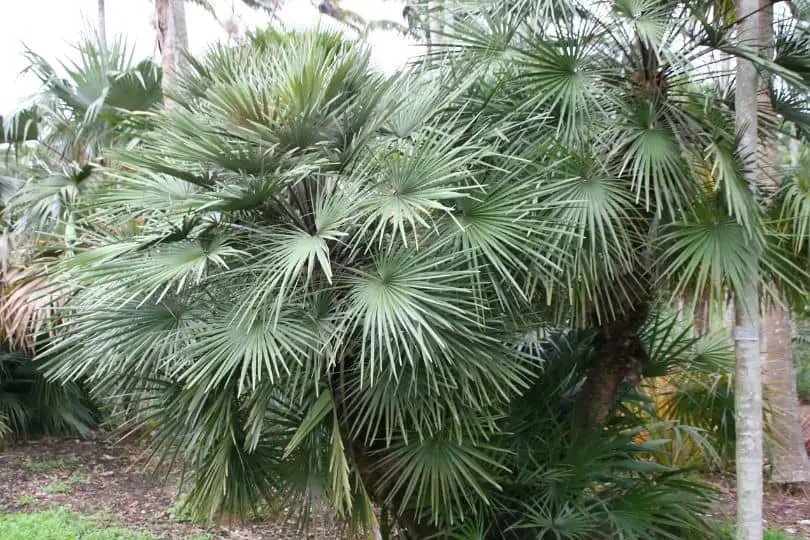
- Scientific Name: Chamaerops humilis
- Common Name(s): Mediterranean Fan Palm, European Fan Palm
- Mature Height: 10-20 feet
- Native Region: Mediterranean region of Europe
- Uses: Ornamental, landscaping
Chamaerops humilis, sometimes known as the Mediterranean Fan Palm or European Fan Palm, is an intriguing species unique to Europe’s Mediterranean region. This palm is typically small to medium-sized, growing to a mature height of 10 to 20 feet. Its distinct form and resilience make it an excellent choice for landscaping in a wide range of climates.
The Mediterranean Fan Palm, unlike many other palm species, exhibits a clustered growth pattern, forming many trunks and giving it a bush-like look. It has fan-shaped leaves with spiky petioles that stretch out in different directions, creating an eye-catching visual display of several fan-like layers in a rich blue-green hue.
These hardy palms can withstand cooler temperatures, gales, and even light frosts, making them a popular choice for temperate climates. Furthermore, they love full sunlight but may also thrive in moderate shade, giving them more options for placement in a landscape.
The multi-stemmed growth pattern of the Mediterranean Fan Palm allows it to compliment a wide range of landscaping design components. It is frequently employed as a focal point in small gardens or as an under-planting in larger landscape projects. With its distinct attractiveness and adaptability, it plays an important role in transforming urban environments into lush, green getaways.
The Mediterranean Fan Palm is a low-maintenance plant that requires frequent watering. This palm’s resilience to diseases and pests, combined with its great visual appeal, makes it a popular choice among gardeners. Furthermore, the lush, tropical vibe it exudes may instantly liven up any outdoor space.
6. Saw Palmetto
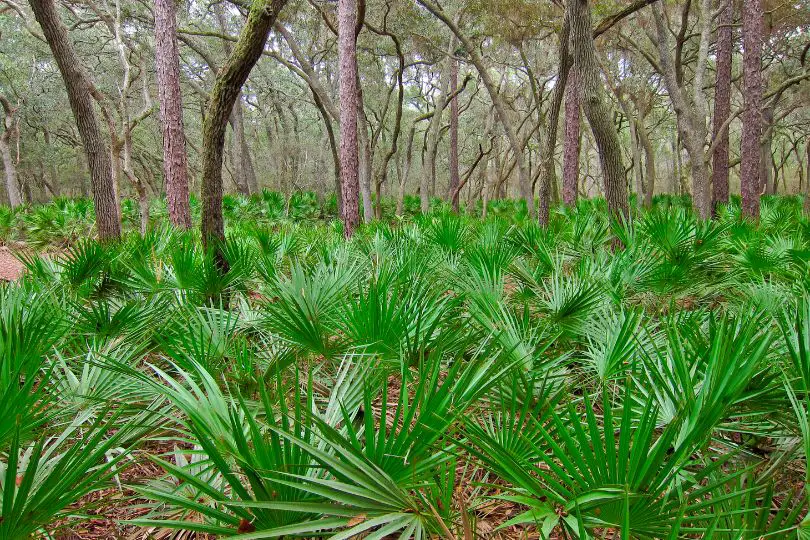
- Scientific Name: Serenoa repens
- Common Name(s): Saw Palmetto, Sabal Palm
- Mature Height: 2-7 feet
- Native Region: Southeast United States
- Uses: Ornamental, landscaping, medicinal
Serenoa repens is a slow-growing, low-lying palm native to the Southeast United States. It is also known as Saw Palmetto or Sabal Palm. It is one of the shortest palm trees in Mississippi with its mature height normally ranges from 2 to 7 feet, making it an excellent choice for undergrowth or privacy screening in landscaping.
The Saw Palmetto seems bushy, with a dense cluster of stems emerging from a single base. Its leaves are fan-shaped, rigid, and deeply divided, and it has a distinctive saw-tooth leaf stem, giving it the common name Saw Palmetto. These leaves have an eye-catching bluish-green tint and look great in any landscape.
The Saw Palmetto, known for its exceptional hardiness, can resist excessive temperatures, poor soil quality, and even hurricanes. It grows well in both full sun and partial shade and, once established, takes very little water, making it an excellent choice for xeriscaping – landscaping that decreases or eliminates the need for irrigation.
Aside from its decorative value, Saw Palmetto is appreciated for its medical properties. The berries, in particular, are used to create natural prostate health therapies. With its unusual appearance and strong character, this multi-faceted palm continues to enchant garden aficionados.
7. Needle Palm
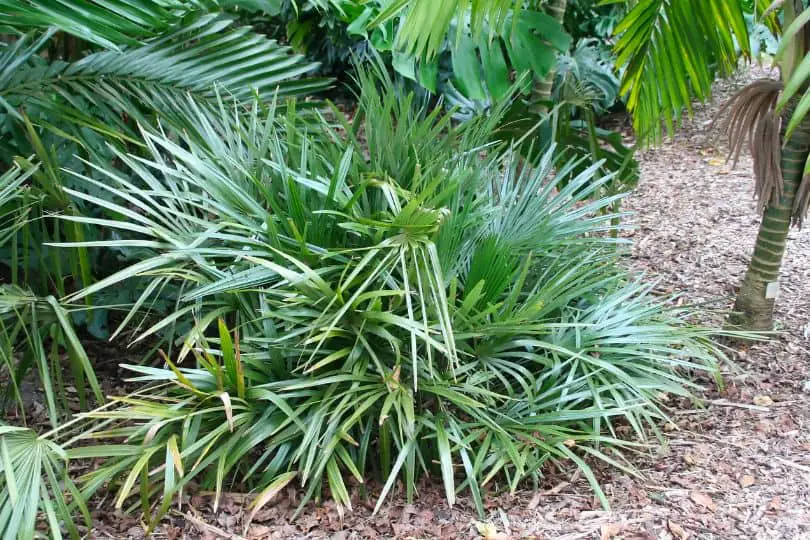
- Scientific Name: Rhapidophyllum hystrix
- Common Name(s): Needle Palm
- Mature Height: 6-8 feet
- Native Region: Southeast United States
- Uses: Ornamental, landscaping, cold-resistant gardens
Rhapidophyllum hystrix, also known as the Needle Palm, is a striking plant native to the southeastern United States. Its mature height of 6 to 8 feet makes it a substantial addition to any garden or landscape. It gets its name from the black needle-like spines that grow at the base of the leaves and act as a unique type of plant defense.
The fan-shaped leaves of the Needle Palm are dark green and glossy, sprouting immediately from the ground and forming a dense clump. The plant’s eye-catching texture, small size, and decorative appeal all contribute to its growing popularity in landscape design.
This palm is well-known for being one of the most cold-resistant palm species on the planet. It can withstand temperatures as low as -5 degrees Fahrenheit, making it a great choice for cold climates where other palms would perish. Despite their cold resistance, they thrive best in partial to full shade and well-drained soils.
Needle Palms are generally used for aesthetic purposes in landscaping. Their distinctive form, leaf, and overall size make them an appealing ground-cover plant that creates a tropical feel even in non-tropical locations. They can be used as a single plant, but they also look great when clustered together in arrangements.
The Needle Palm, with its low maintenance and drought tolerance once established, demonstrates that exquisite and luxuriant tropical landscaping isn’t limited to warm areas. Its distinct features, combined with its adaptability, make it an enticing choice for both gardeners and landscape designers.
8. Sago Palm
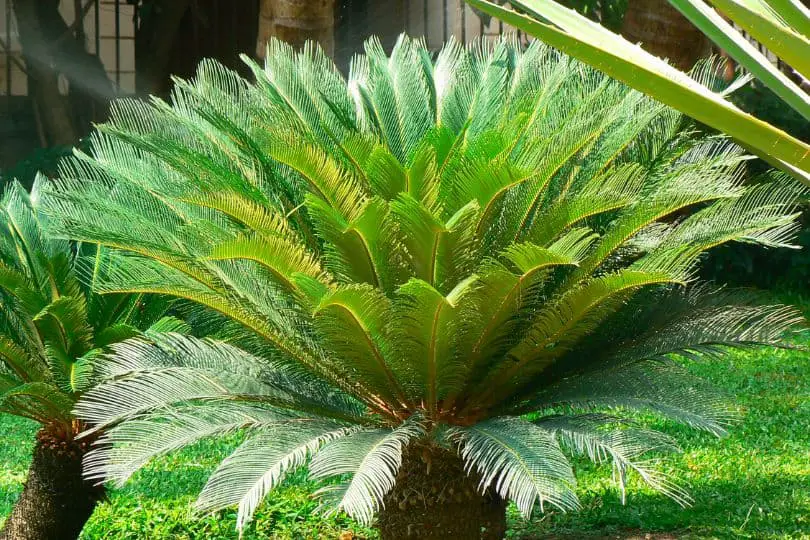
- Scientific Name: Cycas revoluta
- Common Name(s): Sago Palm, King Sago
- Mature Height: 10-12 feet
- Native Region: Southern Japan
- Uses: Ornamental, potted plants, landscaping
The Cycas revoluta, also known as the Sago Palm or King Sago, is an intriguing plant species native to Japan’s southern areas. Despite its name, it is a cycad, one of the oldest ancient plant groups on the planet. This attractive species, with a typical mature height of 10-12 feet, is ideal for residential gardens or as an indoor houseplant.
A broad, cylindrical stem and a crown of leathery, feather-like fronds distinguish Sago Palms. These fronds form a rosette like a rich green fan as they develop in a circular arrangement and arch outward. The plant’s primitive appearance adds visual interest and breaks up the monotony of normal green foliage.
This hardy species enjoys a warm, humid habitat, although it may also tolerate colder temperatures. It grows well on well-drained soil, whether sandy or clay, and needs moderate sunlight, making it an excellent choice for both indoor and outdoor gardening.
Its refined appearance lends itself perfectly to embellishment. Sago Palms are a noteworthy addition to a landscape, acting as a prominent focus point due to its stunning shape and brilliant green hue. Their small stature also lends itself well to pot culture, bringing an exotic touch to patios, balconies, and interiors.
Despite its beauty, it’s crucial to remember that all components of the Sago Palm are deadly if consumed, therefore they must be placed with caution, especially if pets or children are present. With this in mind, this prehistoric beauty continues to be an interesting and appealing choice for a variety of gardening styles.
9. Dwarf Palmetto
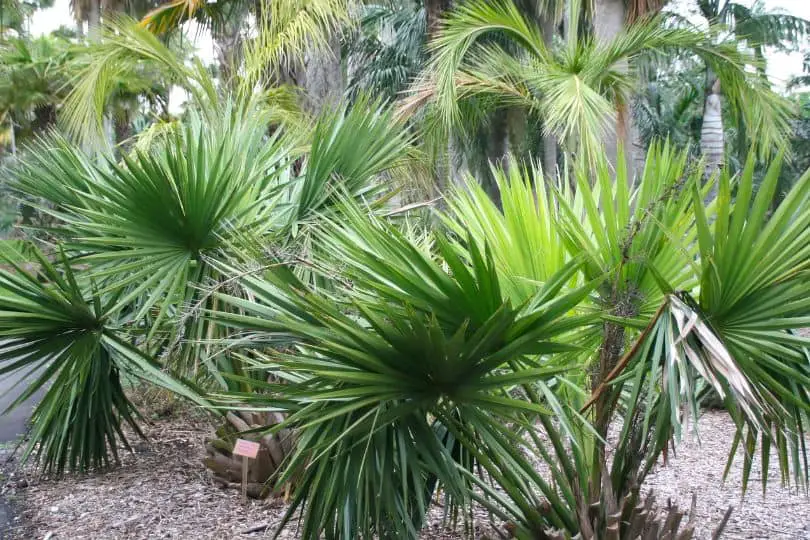
- Scientific Name: Sabal minor
- Common Name(s): Dwarf Palmetto, Blue Palmetto
- Mature Height: up to 10 feet
- Native Region: Southeastern United States
- Uses: Ornamental, landscaping, wildlife habitat
Sabal minor, often known as the Dwarf Palmetto or Blue Palmetto, is a rare palm native to the southeastern United States. Its tiny size, with a maximum height of up to 10 feet, distinguishes it from most other, larger palm kinds, earning it the ‘Dwarf’ moniker.
This palm is distinguished by its large fan-like leaves that emerge directly from the ground without the presence of a conspicuous stem. These huge, spherical, blue-green leaves are sharply split into several pieces and provide a striking contrast to the traditional green garden backdrop. Its modest stature and bushy look make it an appealing addition in landscaping schemes, especially as a ground cover or border plant.
The Dwarf Palmetto is a hardy plant that thrives in a wide range of environments. It can thrive in a variety of soil types, tolerates high heat and cold, and even resist periodic flooding, really embodying diversity and tenacity. Despite its toughness, it thrives best in full sun to partial shade.
Because of its dense leaves and fascinating texture, the Dwarf Palmetto is a noteworthy landscaping feature. This palm contributes greatly to the overall design of coastal or woodland gardens by creating a lush, tropical impression. Furthermore, their blackberries provide food for wildlife, promoting a biodiverse environment.
Similar Articles
- Native Flowering Trees In Mississippi
- Common Fruit Trees In Mississippi
- Native Pine Trees In Mississippi
- Native Oak Trees In Mississippi
- Native Maple Trees In Mississippi
- Common Birch Trees In Mississippi
- Native Elm Trees In Mississippi
- Native Magnolia Trees In Mississippi
- Native White Flowering Trees In Mississippi
- Common Pink Flowering Trees In Mississippi
- Native Purple Trees In Mississippi
- Native Plum & Cherry Trees In Mississippi
- Native Ash Trees In Mississippi
- Native Cypress Trees In Mississippi
- Native Hickory Trees In Mississippi
- Native Nut Trees In Mississippi
Common Palm Trees In Mississippi – Sources
The Regional Gardening team makes sure that the information in our articles is accurate by only using sources that are known to be trustworthy. Some of these sources are peer-reviewed journals from government agencies, well-known universities, and scientific research organizations.
- Native Trees For Mississippi Landscapes, Mississippi State University Extension.
- Mississippi Trees, Publications Of Mississippi Forestry Commission.
- Department Of Plant & Soil Sciences, Mississippi State University Extension.
- Tree Care, Mississippi Urban Forest Council.


